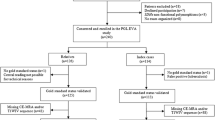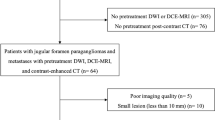Abstract
The purpose of this study was to determine the efficiency of Multidetector Computed Tomography (MDCT) versus MRI in detection and characterization of paragangliomas and differentiating them from other vascular mimicking conditions in the neck and skull base in comparison with histo-pathological results as a gold standard. A prospective study included 30 patients with vascular neck lesions. They were susceptible for MDCT and MRI for characterization of the nature of the lesions. Histo-pathological evaluation was performed in all lesions for confirmation. As a result of this study included 30 patients: 22 males and 8 females. Paragangliomas were the commonest detectable lesions; 12/30 patient had glomus tumor (1 glomus tympanicum, 2 glomus vegale, 4 glomus jugulo-tempanicum, and 5 glomus jugular), 6 carotid body tumor, 2 hemangiopericytoma, 3 vegal Schwanoma, 4 lymphadenopathy, 2 juvenile angiofibroma, and one neurofibroma. The sensitivity of MDCT was higher than MRI in differentiation of paragangliomas from other mimicking lesions, where MDCT sensitivity was 83.33 % and the NPV was 80 % while that of MRI was 77.7 % and the NPV 75 %, but both techniques have moderate agreement between them in differentiating paragangliomas from other mimicking vascular lesion. MDCT with its new utilities has near degree of accuracy in detection and localization of paragangliomas as the same that of MRI. Both techniques have moderate agreement between them in differentiating paragangliomas from other mimicking vascular lesions. So, it is better to use both of them as complementary techniques for accurate diagnosis and grading of paraganglioma.





Similar content being viewed by others
References
Maves MD (1993) Vascular tumors of the head and neck. In: Bailey BJ (ed) Head and Neck Surgery-Otolaryngology. J.B. Lippincott, Philadelphia, pp 1397–1409
Arnold SM, Strecker R, Scheffler K, Spreer J, Schipper J, Neumann HP, Klisch J (2003) Dynamic contrast enhancement of paragangliomas of the head and neck: evaluation with time resolved 2D MR projection angiography. Eur Radiol 13:1608–1611
Van den Berg R (2005) Imaging and management of head and neck paragangliomas. Eur Radiol 15(7):1310–1318
Kliewer KE, Wen D-R, Cancilla PA, Cochran AJ (1989) Paragangliomas: assessment of prognosis by histologic, immunohistochemical, and ultrastructural techniques. Hum Pathol 20:29–39
Rao BA, Koeller KK, Adair CF (1999) From the archives of the AFIP paragangliomas of the head and neck: radiologic-pathologic correlation. Radiographics 19:1605–1632
Dhiman DS, Sharma YP, Sarin NK (2000) US and CT in carotid body tumor. Indian J Radiol Imaging 10:39–40
Beenken SW, Urist MM (2002) Head and neck tumors. Current surgical diagnosis and treatment, Mexico, pp 282–297
Wein RO, Chandra RK, Weber RS (2004) Disorders of head and neck. In: Schwartz’s principles of surgery. McGraw-Hill, New York, pp 513–543
Michaely HJ, Herrmann KA, Dietrich O, Reiser MF, Schoenberg SO (2007) Quantitative and qualitative characterization of vascularization and hemodynamics in head and neck tumors with a 3D magnetic resonance time-resolved echo-shared angiographic technique (TREAT)—initial results. Eur Radiol 17:1101–1110
Whalen RK, Althausen AF, Daniels GH (1991) Extra-adrenal pheochromocytoma. J Urol 147:1–10
Buckley KM, Whitman GJ (1995) Diaphragmatic pheochromocytoma. Am J Radiol 165:260
Gulya AJ (1993) The glomus tumor and its biology. Laryngoscope 103:7–15
Baysal BE, Ferrell RE, Willett-Brozick JE et al (2000) Mutations in SDHD, a mitochondrial complex II gene, in hereditary paraganglioma. Sci 287:848–851
Niemann S, Muller U (2000) Mutations in SDHC cause autosomal dominant paraganglioma, type 3. Nat Genet 26:268–270
Sahdev A, Sohaib A, Monson JP (2005) B, Chew S L and Reznek RH. CT and MR imaging of unusual locations of extra-adrenal paragangliomas (pheochromocytomas). Eur Radiol 15:85–92
Van den Berg R (2005) Imaging and management of head and neck paragangliomas. Eur Radiol 15:1310–1318
Quint LE, Glazer GM, Francis IR, Shapiro B, Chenevert TL (1987) Pheochromocytoma and paraganglioma: comparison of MR imaging with CT and I-131 MIBG scintigraphy. Radiol 165:89–93
Olsen WL, Dillon WP, Kelly WM, Norman D, Brant-Zawadzki M, Newton TH (1987) MR imaging of paragangliomas. AJR 148:201–204
Van den Berg R, Verbist BM, Mertens BJA, van der Mey AGL, Van Buchem MA (2004) Head and neck paragangliomas: improved tumor detection using contrast-enhanced 3D time-of flight MR angiography as compared with fat-suppressed MR imaging techniques. Am J Neuroradiol 25(5):863–870
Van Gils APG, Van den Berg R, Falke THM et al (1994) MR diagnosis of paraganglioma of the head and neck: value of contrast enhancement. Am J Roentgenol 162:147–153
Swartz JD, Harnsberger RH, Mukherji SK (1998) The temporal bone. Radiol Clin North Am 36:819–853
Noujaim SE, Pattekar MA, Cacciarelli A, Sanders WP, Wang AM (2000) Paraganglioma of the temporal bone: role of magnetic resonance imaging versus computed tomography. Top Magn Reson Imaging 211(2):108–122
Bozek P, Kluczewska E, Lisowska G, Namysłowski G (2011) Imaging and assessment of glomus jugulare in MRI and CT techniques. Otolaryngol Pol 65(3):218–227
Casselman JW (2005) The skull base: tumoral lesions. Eur Radiol 15:534–542
Dhiman DS, Sharma YP, Sarin NK (2000) US and CT in carotid body tumor. Indian J Radiol 10(1):39–40
Author information
Authors and Affiliations
Corresponding author
Rights and permissions
About this article
Cite this article
Amin, M.F., Ameen, N.F.E. Diagnostic efficiency of multidetector computed tomography versus magnetic resonance imaging in differentiation of head and neck paragangliomas from other mimicking vascular lesions: comparison with histopathologic examination. Eur Arch Otorhinolaryngol 270, 1045–1053 (2013). https://doi.org/10.1007/s00405-012-2084-6
Received:
Accepted:
Published:
Issue Date:
DOI: https://doi.org/10.1007/s00405-012-2084-6




